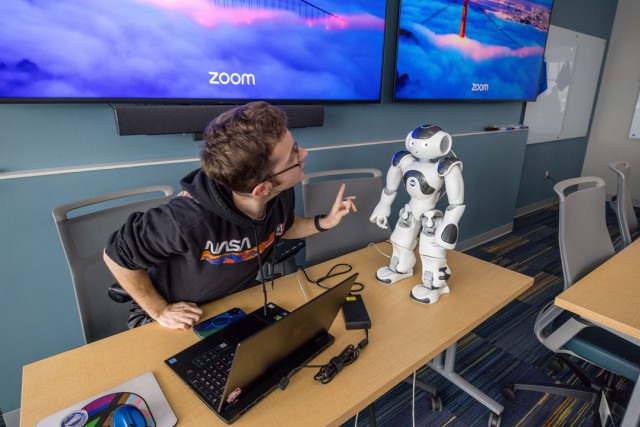Golisano Institute for Sustainability team at RIT to lead U.N. workshop in Ghana
Researchers exploring strategies, policy development for sustainable consumer electronics in West Africa
Mia Medina Mueller/RIT
Allen Luccitti, senior research engineer at Golisano Institute for Sustainability, disassembles one of the study products for data collection and analysis inside the remanufacturing testbed in Louise Slaughter Hall, home to the Center for Integrated Manufacturing Systems (CIMS), one of RIT’s applied research and industry outreach centers.
A research team from Golisano Institute for Sustainability (GIS) at RIT is headed to West Africa later this month to facilitate an important discussion regarding the current state of consumer electronic product (CEP) markets in the Republic of Ghana.
Nabil Nasr, associate provost and director of GIS; Michael Thurston, technical director and research faculty; and Chelsea Gulliver, economic and policy analyst, will lead a workshop, “Advancing the Circular Economy in Consumer Electronic Markets” on Jan. 24-25 in Accra, Ghana, on behalf of the United Nations Environment Programme (UNEP), the International Resource Panel (IRP), and the Ministry of Environment, Science, Technology and Innovation (MESTI).
The workshop is designed to be a consultation aiming to understand:
- The current state of waste management and recycling in Ghana;
- The current state of consumer electronic markets in the West African country;
- The technological, logistical, policy, and market conditions necessary to enable the upscale of value retention processes (VRPs) and implementation of circular economy strategies in Ghana, including opportunities and barriers.
Both UNEP and the IRP are currently involved in studies that promote a decoupling of economic growth from environmental degradation, according to Nasr. The goal of these studies is to clarify the relationships between industrial processes in material and product manufacturing, and their impacts on economic and environmental outcomes, he added.
“One such method to achieve this goal is through the advancement of circular and regenerative production processes, namely the circular economy,” said Nasr, who cited the additional contributions of researchers supporting the project, including Allen Luccitti, senior staff engineer, and sustainability Ph.D. student Kyle Parnell. “However, scientific analysis of the viability of, as well as barriers to and opportunities in circular economy policy development, have not been fully explored in sectors such as the consumer electronic products sector.”
The upcoming workshop is designed to change that. In the age of information, access to consumer electronic products is critical to the techno-economic and social development of society, according to information on the workshop. The manufacturing and retail of CEPs comprise significant portions of industrial economic productivity; some worldwide estimates suggest global industry revenues reached $1 trillion in 2020 and will grow to $1.5 trillion by 2026.
Consequently, the manufacture, distribution, use, and end-of-life disposal of CEPs are responsible for considerable impacts, from material waste and toxicity to greenhouse gas emissions, to material depletion and land use change, to the adverse implications of these effects on human health and development.
In addition, CEPs often require critical raw materials, create high energy demand in manufacturing and use, and result in a hazardous waste stream. Existing resource efficiency and circular economy strategies employed in CEP sectors—including recycling and resale in secondary markets—do not adequately manage these issues, and leave challenges in waste disposal (e.g. unusable or toxic materials) virtually unaddressed, Nasr said.
Since CEPs represent one of the fastest growing waste streams worldwide, the IRP and RIT are currently studying the methodology and approaches needed to expand the role of value-retention processes (VRPs) in CEP markets. This will involve modelling the potential economic value and environmental impacts, and develop guidance for policy and decision-makers, the results of will comprise the study’s findings.
Nasr said exploring the expansion of the role of VRPs in CEP markets is the direct result of an invitation that came out of a 2019 G7 Environment Ministers’ meeting, asking the IRP “to continue its work on value-retention processes (remanufacturing, refurbishment, repair, and direct reuse) that support resource efficiency as a contribution to the G7 Alliance on resource efficiency’s planned work on value retention, notably by addressing their potential in the consumer goods sector.”
The case study nations of the U.S. and Ghana were selected with the intention to provide sound representations of industrial, economic, and environmental conditions in Global North and Global South markets, respectively. As a result, technical conclusions and corresponding policy recommendations generated from case-specific models may serve as functional guidelines in other contexts that share similar characteristics of industrial infrastructure, policy frameworks, and customer/market behavior.
It is believed that CEP markets in Ghana can benefit from the findings of the study through increasing the economic growth opportunities associated with VRP uptake, such as increased labor force skills, widened CEP market access to new consumer segments, greater efficiency in resource use and recovery, and the potential to decrease environmental and human health hazards. Before determinations can be made, however, investigations will need to assess circular economy applicability in Ghana regarding the current state of CEP. This assessment will require the input of the stakeholders who interact directly with CEPs.
The discussion will be undertaken with a mix of stakeholders, including national government, local government, recyclers, and repair shop representatives.




